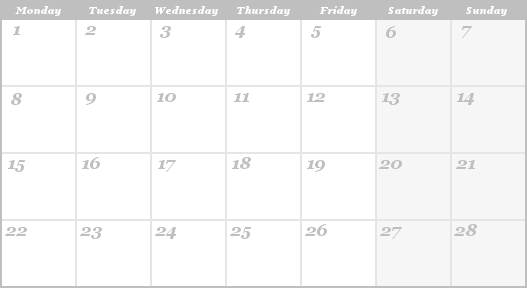Explore the XRS Calendar Demo
"I've been on a calendar, but I've never been on time." ~ Marilyn Monroe
On this page is a demo app that you can use online to discover the look and feel of the Extended-Range Secular Calendar, and familiarize yourself with how it works. Please note that because this is only a demo version, you won't have access to all the features of the full XRS Calendar app, including the complete range of dates available in the actual XRS Calendar. Accordingly, the button labeled Epoch has been disabled, since the XRS epoch lies well outside the range of dates permitted within this demo.
One of the first things you'll notice is that when this page loads, the calendar displays today's XRS Calendar date, highlighed in red type to distinguish it from the rest.1 Roll your mouse over the other dates on the calendar body, and watch the numerals become larger as you hover over them. Now click on one of the date cells, and watch as that date becomes the new "active date" for the calendar. As the active date changes, so too do the three date formats along the bottom. The first is an ISO 8601 semblance of the active date; the other two raw numbers convey the Julian Day number and Epochal Day number of the active date.
Using the Control Panel
This is not the only way to navigate through the days, however. Move up to the control panel at upper right, and you will find a column of arrows pointing forward (right) and backward (left) in time. The six letters D, M, Y, D, C, and M signify that the pair of arrows around each letter will be used to navigate Days, Months, Years, Decades, Centuries, and Millennia, respectively. (As a reminder, if you roll your mouse over any arrow for a second or so, you will see a tooltip that shows what that arrow does when you click on it.) Now use the topmost pair of arrows to move forward, then backward, through the days of the month. Select the 25th of the month from the calendar body, then use the top right arrow of the control panel to move forward day-to-day until you've reached the 28th, and just beyond. You should be situated at the 1st of the following month.
Next, use the second pair of arrows from the top—the ones labeled with the topmost of two Ms—to go month-to-month. Note that after the month of December, you will have reached the three months of the XRS Calendar that are named somewhat unconventionally: Undecimber, Duodecimber, and Tredecimber. Move to Tredecimber, select the 25th, and go forward day-to-day. What happens? The main calendar becomes deactivated, and the little Intercalary cell—the one you may have been wondering about since you began using this app!—now becomes active. (As you activate the Intercalary period, have a look at the ISO 8601 semblance date at far left, and note how that date has been rendered. Note too that there is never any day of the week associated with the Intercalary period. That's because the Intercalary period is entirely separate and distinct from any regular month or week.) When you advance beyond the Intercalary period, you should reach March of the following year, and the Intercalary cell becomes inactive once more until you've navigated to what is virtually the end of the year.
Now play with the arrows labeled Y. As you move through the years, you will see that most years contain one Intercalary cell, while occasionally a year contains two such cells. The latter are leap years in the XRS Calendar. An XRS leap year always has two Intercalary days appended to the end: Intercalary 1 is the normal 365th day—a feature of every year—while Intercalary 2 is the 366th, "leap-year day." Note for now that in most instances the leap years occur four years apart, while in roughly one-eighth of all cases it takes five years to move from one leap year to the next.
Lastly, don't be concerned about losing your bearings, or, more seriously, having to backpedal many years or centuries just to return to a point that's closer to the present day. Simply click the button labeled Today to reset the calendar to today's UTC date, and go from there.
It's time to pause and reflect on some of the features just seen. Have you noticed that there isn't a single month with even one empty date cell in it? That there is no month with anything other than four weeks? No month with anything other than 28 days? That the days of the week never change in relation to the calendar dates? That each of the 13 months2 is in fact identical to all the others, except in name only?
Pretty boring, huh?
But that's the point: The XRS Calendar is just that: simple, stable, permanent. It never changes until it has to change, at which time the Intercalary periods take over, stabilizing the calendar to accord with the mean northward equinoctial year, and doing so year after year. Sometimes it's good to procrastinate! (;-}=
Have you noticed as well that this app displays the entire calendar as a single month accompanied by either one or two date cells representing the Intercalary period? There's a reason for that. If the XRS Calendar had been made into a conventional wall calendar, all that would be required are just these two components, rendered on a type of whiteboard or chalkboard, with a handy list of leap years imprinted on the board as well. With an erasable marking pen or chalk, and eraser, the user could then just erase the contents of the previous month, and write in the new month as necessary. Gone would be the need to burn through forests by manufacturing wall calendars with twelve distinct pages. Gone would be the need to create new wall calendars year after year, thereby ravaging even more forests, and consuming more energy and many other resources besides.
Delimiters in the Calendar Apps
Those who have access to an unrestricted version of this app are probably going to town with the XRS Calendar, moving by centuries, even millennia. Thus the question may arise, "Are there limits to how far forward and backward in time I can go in this calendar?" Yes. The XRS Calendar is constrained by the knowledge we currently have regarding changes in the length of the mean northward equinoctial year (MNEY) over time. At present we have a fairly good theoretical foundation for retrodicting and predicting the length of the MNEY from about -100000 to +100000. Accordingly, the unrestricted versions of this calendar demo are equipped with delimiters that prohibit moving prior to -94167 March 1, and beyond 104045 Intercalary 2. Just keep in mind that (1) these apps are designed to demonstrate how the XRS Calendar would function assuming that no changes are ever made to its existing arithmetical leap-year schema, and (2) leap-year cycles prior to the XRS year -3533 and beyond the year 14975 are theoretical still, and therefore somewhat speculative. (The unrestricted versions denote these theoretical regions by changing the color of the year from black to red, alerting viewers that they should regard leap-year cycles in these regions with caution.) These theoretical regions will indeed be subject to change in the future (particularly the region beyond 14975) as more accurate astronomical data and methods are realized.
But If You're Still Stuck with this Demo Version...
...you won't have quite the range with this version as you would otherwise have. For the demo version, the delimiters are set to 6800 March 1 and 7100 Intercalary 2. These delimiters provide a range of 301 years, which is adequate to demonstrate the "Zen" of doing things the XRS Calendar way. Nevertheless, this limited range just pales in comparison to the vast expanse of the XRS Calendar's actual range, which is just over 198,200 years. In the coming months, native versions of this calendar demo will be produced for mobile devices such as smartphones and tablets, and eventually, desktop and laptop computers. Once you have one or more of these apps on hand, you will marvel at how the leap years begin to accumulate more and more frequently as you navigate from the pastward end of the calendar's extended range all the way to its futuremost end! Native versions of the demo will also be coupled with a datebook for logging important events, historical dates, birthdays, anniversaries, and more, in terms of both the XRS and Gregorian calendars. The plan of development also calls for unrestricted versions of the date conversion app and the day-of-week conversion app, all bundled together in one package.
Looking Ahead to Date Conversion
When we move to the XRS Calendar's date conversion app, we will find that it deploys a much smaller range of available dates than does the calendar app, which operates over a range of nearly 200 millennia. That's because converting dates from one calendar to another becomes meaningless if we cannot be certain as to the accuracy of our conversion. Still, native versions of the date conversion app will allow a range of just over 18,500 years in which to make the conversions. That's quite a lot of years, come to think of it!
Notes
1. Another feature you may have noticed right away is that the days of the workweek in most Western nations— Monday through Friday—are rendered in white, while the weekend days Saturday and Sunday are rendered in a contrasting light gray. This contrast is not particularly significant, except to show graphically that weekend days appear consecutively, at the end of every week, rather than being split apart and awkwardly shunted to opposite sides of the week, as the Gregorian Calendar has them.
2. You may have also noticed that, despite the 13-month configuration, there is no such thing as Friday the 13th in the XRS Calendar! But that fact is incidental to the calendar's design, not an integral, willful part of it. It's an important point of the XRS Calendar to eschew superstition, not to encourage or embrace it—whether or not such superstition redounds in favor of the calendar.

















